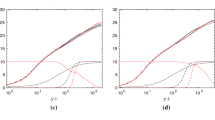Abstract
A modified transition model is given based on the shear stress transport (SST) turbulence model and an intermittency transport equation. The energy gradient term in the original model is replaced by flow strain rate to saving computational costs. The model employs local variables only, and then it can be conveniently implemented in modern computational fluid dynamics codes. The fifth-order weighted compact nonlinear scheme and the fourth-order staggered scheme are applied to discrete the governing equations for the purpose of minimizing discretization errors, so as to mitigate the confusion between numerical errors and transition model errors. The high-order package is compared with a second-order TVD method on simulating the transitional flow of a flat plate. Numerical results indicate that the high-order package give better grid convergence property than that of the second-order method. Validation of the transition model is performed for transitional flows ranging from low speed to hypersonic speed.
Similar content being viewed by others
References
Fu S, Wang L. RANS modeling of high-speed aerodynamic flow transition with consideration of stability theory. Prog Aerospace Sci, 2012, http://dx.doi.org/10.1016/j.paerosci.2012.08.004
Wang L, Fu S. Modelling flow transition in a hypersonic boundary layer with Reynolds-averaged Navier-Stokes approach. Sci China Ser G-Phys Mech Astron, 2009, 52(5): 768–774
Wang L, Fu S. Development of an intermittency equation for the modeling of the supersonic/hypersonic boundary layer flow transition. Flow Turbulence Combust, 2011, 87: 165–187
Wang L, Fu S, Carnarius A, et al. A modular RANS approach for modelling laminar-turbulent transition in turbomachinery flows. Int J Heat Fluid Flow, 2012, 34: 62–69
Warren E S, Hassan H A. A transition closure model for predicting transition onset. J Aircraft, 1998, 35(5): 769–775
Papp J L, Kenzakowski D C, Dash S M. Extensions of a rapid engineering approach to modeling hypersonic laminar to turbulent transitional flows. AIAA Paper, 2005, AIAA-2005-892
Menter F R. Zonal two equation k-? turbulence models for aerodynamic flows. AIAA Paper, 1993, AIAA-93-2906
Roy C J, Blottner F G. Review and assessment of turbulence models for hypersonic flows. Prog Aerospace Sci, 2006, 42: 469–530
Celic A, Hirschel E H. Comparison of eddy-viscosity turbulence models in flows with adverse pressure gradient. AIAA J, 2006, 44(10): 2156–2169
Deng X, Zhang H. Developing high-order accurate nonlinear schemes. J Comput Phys, 2000, 165: 22–44
Deng X. High-order accurate dissipative weighted compact nonlinear schemes. Sci China Ser A-Math Phys Astron, 2002, 45(3): 356–370
Deng X, Mao M, Tu G, et al. Extending weighted compact nonlinear schemes to complex grids with characteristic-based interface conditions. AIAA J, 2010, 48(12): 2840–2851
Deng X, Mao M, Tu G, et al. High-order and high accurate CFD methods and their applications for complex grid problem. Commun Comput Phys, 2012, 11(4): 1081–1102
Nonomura T, Iizuka N, Fujii, K. Freestream and vortex preservation properties of high-order WENO and WCNS on curvilinear grids. Comput Fluids, 2010, 39: 197–214
Zhang H, Zhuang F. NND schemes and their applications to numerical simulation of two- and three-dimensional flows. Adv Appl Mech, 1991, 29: 193–256
Deng X, Mao M, Tu G, et al. Geometric conservation law and applications to high-order finite difference schemes with stationary grids. J Comput Phys, 2011, 230(4): 1100–1115
Tu G, Deng X, Mao M. A staggered non-oscillatory finite difference method for high-order discretization of viscous terms (in Chinese). Acta Aerodyn Sin, 2011, 29(1): 6–11
Schubauer G B, Klebanoff P S. Contribution on the Mechanics of Boundary Layer Transition. NACA TN 3489, 1955
Somers D M. Design and Experimental Results for the s809 Airfoil. SR-440-6918, National Renewable Energy Laboratory, 1997
Denissen N A, Yoder D A, Georgiadis N J. Implementation and Validation of a Laminar-to-Turbulent Transition Model in the Wind-US code. NASA/TM-2008-215451, 2008
Kimmel R L. The effect of pressure gradients on transition zone length in hypersonic boundary layers. J Fluids Eng, 1997, 119: 36–41
Yang Y, Shen Q, Zhan H, et al. Investigation on asymmetric transition about hypersonic boundary layer over a slight blunt cone (in Chinese). J Astronaut, 2008, 29(1): 34–39
Tu G, Deng X, Mao M. Assessment of two turbulence models and some compressibility corrections for hypersonic compression corners by high-order difference schemes. Chin J Aeronaut, 2012, 25(1): 25–32
Catris S, Aupoix B. Density corrections for turbulence models. Aerospace Sci Tech, 2000, 4(1): 1–11
Author information
Authors and Affiliations
Corresponding author
Rights and permissions
About this article
Cite this article
Tu, G., Deng, X. & Mao, M. Validation of a RANS transition model using a high-order weighted compact nonlinear scheme. Sci. China Phys. Mech. Astron. 56, 805–811 (2013). https://doi.org/10.1007/s11433-013-5037-1
Received:
Accepted:
Published:
Issue Date:
DOI: https://doi.org/10.1007/s11433-013-5037-1




